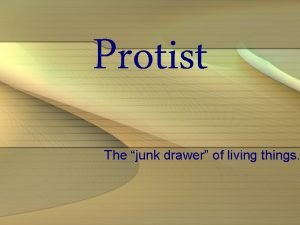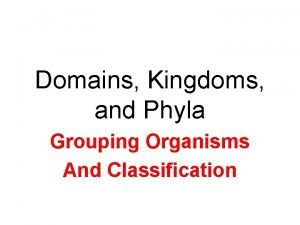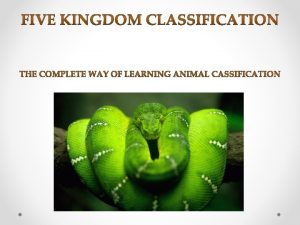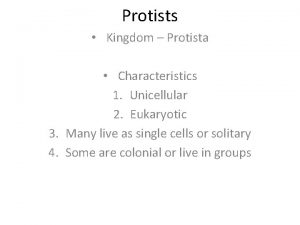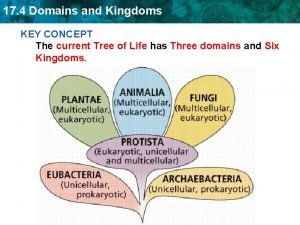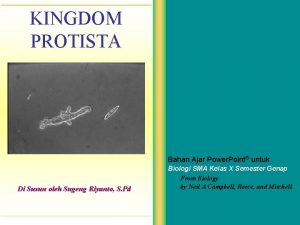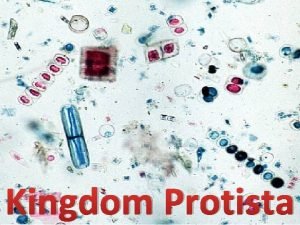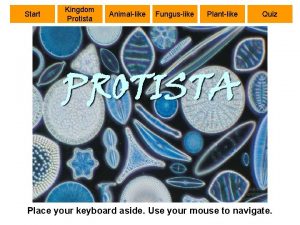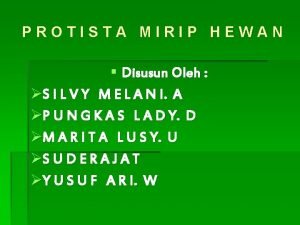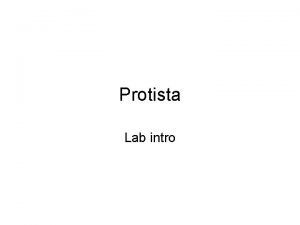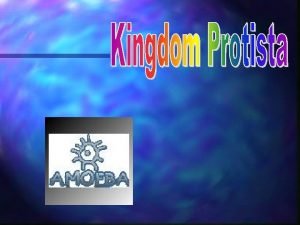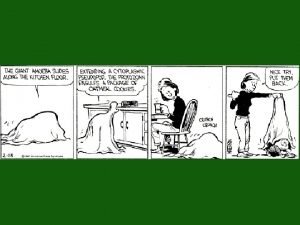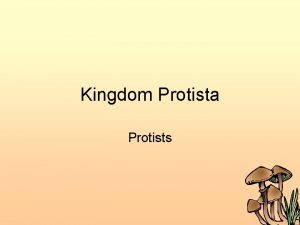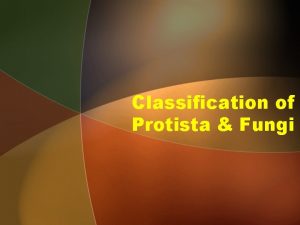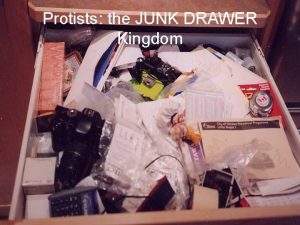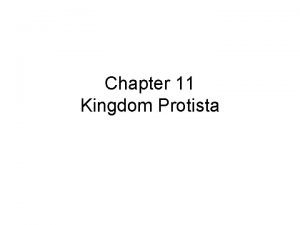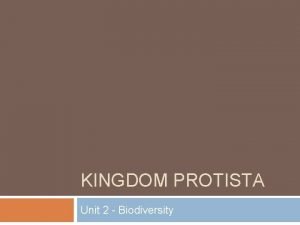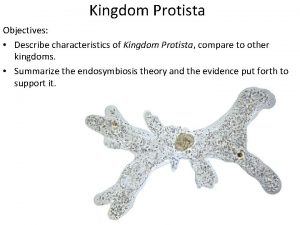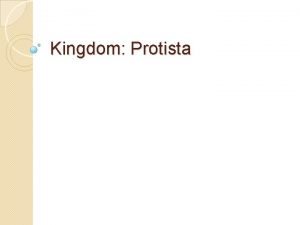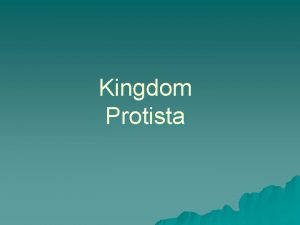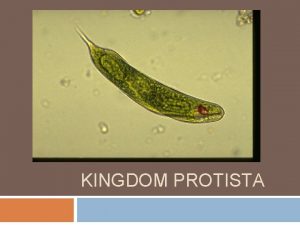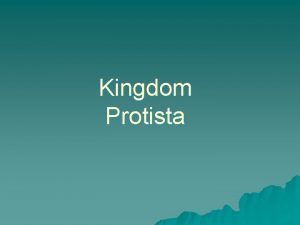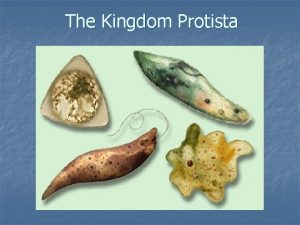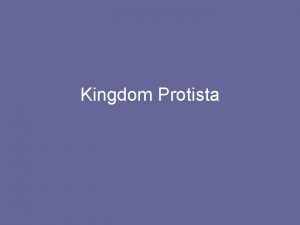KINGDOM PROTISTA The Junk Drawer of Classification Classified






















- Slides: 22

KINGDOM PROTISTA “The Junk Drawer” of Classification

• Classified based on what they are NOT – they are NOT fungi, plants, or animals, but they are eukaryotes (in fact, they were probably the FIRST of the Eukarya) • Most are unicellular & microscopic • Groups (phyla) are based on physical characteristics (such as motility) and nutritional characteristics (heterotroph/autotroph) • First to reproduce sexually; first multicellular organisms • Live where ever there is moisture • Historically, divided into algae (plant-like) and protozoa (animal-like)

Kinds of Protists Use the following slides to complete the table in your notes. Look for: * Distinguishing Characteristics * Mode of Nutrition * Typical Example (sketch it)

Rhizopods Ex) Amoeba • Flexible surface, no cell wall, pseudopodia • Heterotrophs – engulf prey with pseudopodia; endocytosis/phagocytosis nucleus pseudopodia

Amoeba engulfing a paramecium with pseudopodia – An example of phagocytosis (a form of heterotrophy)

JUST FYI – not in your notes! Heliozoans and Radiolarans * Related to amoebas – pseudopodia & phagocytosis Note the long, slender pseudopodia coming from the heliozoan on the left Heliozoans are freshwater; radiolarans are marine Both form the ooze on the floor of these bodies of water with the shells left from their dead bodies

FYI – Not in your notes Foraminiferans – another organism related to the amoebas; note the long pseudopodia coming out of the shell of calcium carbonate - compose sedimentary rock - both heterotrophic and photosynthetic (depending on the species)

Euglenoids/flagellates Example – Euglena • Called flagellates because of their mode of motility • Have an eyespot for phototaxis • Have a contractile vacuole for water balance • Autotrophic/photosynthetic (look at the chloroplasts!) AND heterotrophic

FYI – Not in your notes Trypanosoma – genus of the protist that causes African sleeping sickness in humans (host) following the bite of the tsetse fly (vector) Closely related to the euglenoids because they have similar body coverings.

FYI – Not in your notes Giardia – genus of another flagellated protist that causes disease in humans

Ciliophora - ciliates Example - Paramecium All members of this group have cilia. Note there are even cilia lining the oral groove *Have a contractile vacuole *Have micro and macro nuclei *Heterotrophic – food enters through oral groove, food vacuole forms, lysosomes help digest food LOOK! Waste leaving cell via exocytosis

FYI – Not in your notes Another look at Ciliophorans: Stentor and Paramecium

Dinoflagellates Planktonic, photosynthetic protists – called phytoplankton (phyto = plant) AND heterotrophic species as well Responsible for red tide (named for the photosynthetic pigment they contain); “blooms” of these organisms cause massive kills due to the toxins they produce Heterotrophic species use the toxins to stun prey (like fish) and then feed on its body fluids Some are bioluminescent Also related to the euglenoids (note the presence of the flagella)

Diatoms Another group of protists (actually related to water molds and golden & brown algaes) Shells made of silica house the photosynthetic organism inside The shells are in two parts, fitting together like a shoe box or Petri dish

The Algae – collective term referring to all of the photosynthetic, plantlike protists; alga – singular; algal – adjective • Multicellular • Photosynthetic – the algae along with other photosynthetic protists are the largest group of producers on Earth, producing 1/3 of the oxygen • Have a variety of pigments, on which the name of each group is based (remember, -phyta means “plant”) • Golden algae – Chrysophyta; related to diatoms • Brown algae – Phaeophyta; “seaweed”; also closely related to the diatoms; kelp • Red algae – Rhodophyta; includes some “seaweeds” but not. Form a separate group from the golden & browns algaes and the green algae; some species are heterotrophic • Green algae – Chlorophyta; “seaweeds”; have chlorophyll similar to plants; gave rise to the plant kingdom

Golden algae – microscopic Brown algae –macroscopic this is a kelp forest, supplying habitat and food for an entire ecosystem 60 m 25 nm

Red algae Green algae Volvox (microscopic) multinucleate green algae; these are NOT leaves

Water Mold Oomycota – heterotrophic protist commonly found in very wet environments growing on dead or decaying organisms, such as on the fish below; called “mycota” because they look like fungi (but they’re NOT) - late blight, a water mold, was responsible for the Irish potato famine

Slime Molds Protists that aggregate in times of stress to form spore-producing bodies • Heterotrophic • Look like fungi but are NOT (do not have chitin in cell walls) • 2 types: cellular and plasmodial (you don’t have to know which is which )

Sporozoans Protists that are: • Nonmotile *Unicellular • Parasitic *Spore-forming • Disease-causing *Heterotrophic Diseases caused include: • Malaria (host – vertebrates; vector mosquito) • Toxoplasmosis (host – humans & cats) • cattle tick fever (host – cattle, mice, humans, deer, dogs) • Cryptosporidiosis (host – cattle humans, birds, deer, dogs, cats) Malaria sporozoans of genus Plasmodium

Protist Vocabulary This list may not be complete for YOU. If you don’t know these words (or any others in this unit), look them up or ASK! Colony Nonmotile/sessile Aggregation Conjugation Multicellular Alternation of generations Complex multicellularity Pseudopodia Heterotroph/autotroph Photosynthetic Flagella Gamete Cilia Spore Planktonic/plankton Host Silica Vector Spore Parasitic/saprophytic

Rhizopoda Amoeba, related organisms Flexible, no cell wall, pseudopodia, related – shells Heterotrophs – phagocytosis p. 464 Euglenophyta Euglena and related flagellates Flagella Eye spots Autotrophic – photosynthetic & heterotrophic p. 467 Ciliophora Cilia Contractile vacuole Oral groove Heterotrophic p. 469 Dinoflagellates Planktonic Flagellated Toxic – red tide Heterotrophic & autotrophic/photosyntheti c p. 467 Bacillariophyta Diatoms Shells of silica Shoe box like shell Planktonic Photosynthetic p. 466 Algae (golden, brown, red & green) Many multicellular Photosynthetic p. 461, 465 “-mycota” groups; water molds & slime molds Fungus-like Some aggregate in times of stress; spores Heterotrophic p. 470 Sporozoans Complex life cycle Apicomplexa nonmotile, unicellular, parasitic, spore-forming, disease-causing Heterotrophic p. 471 & p. 473 Paramecium and related ciliates
 Junk drawer kingdom
Junk drawer kingdom Junk drawer robotics
Junk drawer robotics Old kingdom middle kingdom new kingdom
Old kingdom middle kingdom new kingdom Nnn ruled
Nnn ruled Old kingdom middle kingdom new kingdom
Old kingdom middle kingdom new kingdom Old kingdom middle kingdom new kingdom
Old kingdom middle kingdom new kingdom Archaebacteria kingdom examples
Archaebacteria kingdom examples Monera classification
Monera classification Protist characteristics
Protist characteristics Protist characteristics
Protist characteristics Dominio eukarya reino protista
Dominio eukarya reino protista Concept mapping chapter 17 domains and kingdoms
Concept mapping chapter 17 domains and kingdoms Kingdom monera protista fungi plantae animalia
Kingdom monera protista fungi plantae animalia Protista ppt
Protista ppt Domain of kingdom protista
Domain of kingdom protista Characteristics of kingdom protista
Characteristics of kingdom protista Kingdom protista
Kingdom protista Introduction to the protists
Introduction to the protists Kingdom protista multicellular unicellular
Kingdom protista multicellular unicellular Protists habitats
Protists habitats Plantae prokaryotic or eukaryotic
Plantae prokaryotic or eukaryotic Kingdom protista members
Kingdom protista members Amoeba kingdom
Amoeba kingdom
